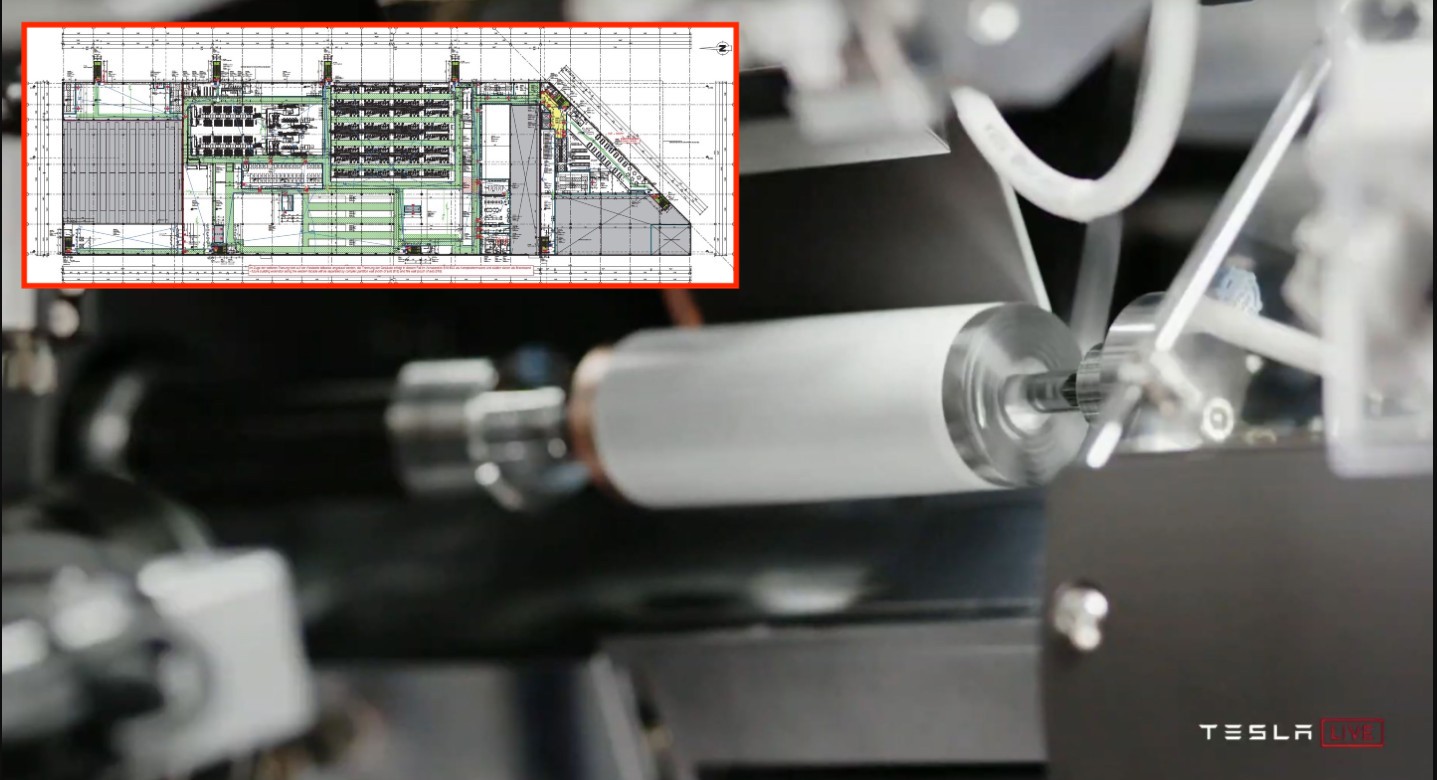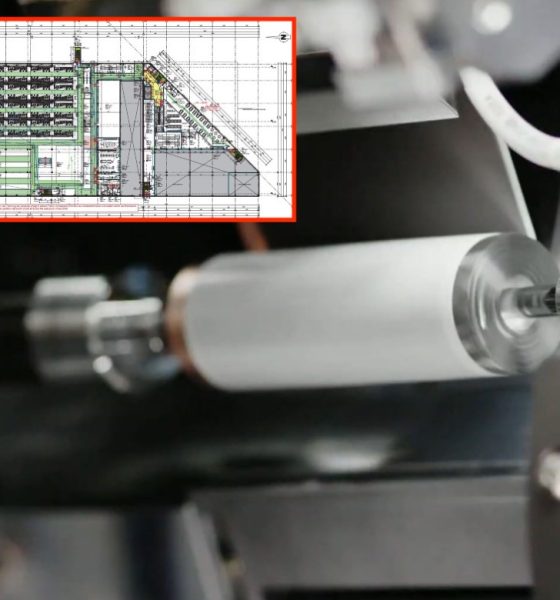

News
Tesla’s 4680 cell production process outlined in Giga Berlin’s revised filings
Tesla’s revised documents for Gigafactory Berlin have been posted online, and they are a treasure trove of information. The documents provided some new details about Tesla’s planned 4680 battery plant in Gigafactory Berlin, which Elon Musk noted is on track to be one of the world’s largest battery production facilities. They also outlined how Tesla’s 4680 cells are produced.
While sections of the filing pertaining to the planned 4680 battery cell plant in Giga Berlin were blacked out due to sensitive information that could not be made public, the documents show some important tidbits about the upcoming facility. This includes the facility’s cell production operations over four floors, with anode and cathode production on the first floor and tabless cell production on the third floor. The battery plant is massive, requiring large foundations similar to Gigafactory Berlin’s Phase 1 zone.
Anode and cathode production in the 1st floor pic.twitter.com/tOoV4b3Iur
— Tobias Lindh (@tobilindh) June 18, 2021
Most importantly, Tesla also submitted a simplified diagram of its 4680 battery cell production process, though most of the diagram was blacked out in the revised filing’s public release. However, the company provided a brief overview of how its new battery cell will be produced in the upcoming facility (roughly translated through Google Translate).
“The battery the Gigafactory Berlin requires special systems and process steps. The anodes and cathodes consist of coated current collector foils. Copper is used as the material for the anode foil and aluminum is used for the cathode foil. The anode and cathode components are manufactured in mixed processes (A020-01 and A020-02), which only use materials in powder form. The new materials used are tested and approved in our own laboratory (A020-11).
“In order for the powder coating to adhere to the two films, they must first be pre-coated with a thin layer of adhesive (substrate) (A020-03 and A020-04). This substrate is delivered in containers. The pre-coating is necessary because a dry coating with powder takes place. After the anode and cathode components have been mixed, they are applied as a coating to the respective substrate-coated film in order to establish electrical contact (A020-05 and A020-06). The current collector foils, coated with the anode or cathode components, result in the finished anode or cathode.
Page 239 pic.twitter.com/7gDk2fSeVy
— Giga Berlin / Gigafactory 4 (@gigafactory_4) June 18, 2021
The revised filings also provided a general idea of how Tesla’s tabless cell production works. Among these is the fact that the finished 4680 cells would be subjected to 10 days’ worth of curing after their formation.
“The anode or cathode is then cut to the required lengths with a laser in the “tabless process” (A020-08). The anode, the cathode and the separator are alternately placed one on top of the other and rolled up into a roll. This roller is then inserted into a metal housing, which is manufactured from steel rollers in a die-cutting and deep-drawing process (A020-07). In the assembly area, the final assembly and filling of the cell takes place with small amounts of electrolyte (approx. 10% of the cell weight) (A020-09).
“The electrolyte is absorbed by the electrode coatings and enables the lithium ions to move back and forth between the anode and cathode. The housing is then closed with a lid in a welding process. The last step is the formation (A020-10) of the cell. In the formation process, the cell is electrically started up by charging and discharging it under different temperature conditions. The finished cell remains in this area for approx. 10 days and is then put to further use. The cells produced are subjected to random quality control in our own laboratory (A020-11).”
A link to Tesla’s filings for Gigafactory Berlin could be found here.
Do you have anything to share with the Teslarati Team? We’d love to hear from you, email us at tips@teslarati.com.

News
Tesla Insurance officially expands to new U.S. state
Tesla’s in-house Insurance program first launched back in late 2019, offering a new way to insure the vehicles that was potentially less expensive and could alleviate a lot of the issues people had with claims, as the company could assess and repair the damage itself.

Tesla Insurance has officially expanded to a new U.S. state, its thirteenth since its launch in 2019.
Tesla has confirmed that its in-house Insurance program has officially made its way to Florida, just two months after the company filed to update its Private Passenger Auto program in the state. It had tried to offer its insurance program to drivers in the state back in 2022, but its launch did not happen.
Instead, Tesla refiled the paperwork back in mid-October, which essentially was the move toward initiating the offering this month.
BREAKING: Tesla Insurance has just officially launched in Florida.
This is the first new state to receive @Tesla Insurance in more than 3 years. In total, Tesla insurance is now available in 13 U.S. states (map in thread below of all the states).
Tesla Insurance in Florida uses… pic.twitter.com/bDwh1IV6gD
— Sawyer Merritt (@SawyerMerritt) December 17, 2025
Tesla’s in-house Insurance program first launched back in late 2019, offering a new way to insure the vehicles that was potentially less expensive and could alleviate a lot of the issues people had with claims, as the company could assess and repair the damage itself.
It has expanded to new states since 2019, but Florida presents a particularly interesting challenge for Tesla, as the company’s entry into the state is particularly noteworthy given its unique insurance landscape, characterized by high premiums due to frequent natural disasters, dense traffic, and a no-fault system.
Annual average premiums for Florida drivers hover around $4,000 per year, well above the national average. Tesla’s insurance program could disrupt this, especially for EV enthusiasts. The state’s growing EV adoption, fueled by incentives and infrastructure development, aligns perfectly with Tesla’s ecosystem.
Moreover, there are more ways to have cars repaired, and features like comprehensive coverage for battery damage and roadside assistance tailored to EVs address those common painpoints that owners have.
However, there are some challenges that still remain. Florida’s susceptibility to hurricanes raises questions about how Tesla will handle claims during disasters.
Looking ahead, Tesla’s expansion of its insurance program signals the company’s ambition to continue vertically integrating its services, including coverage of its vehicles. Reducing dependency on third-party insurers only makes things simpler for the company’s automotive division, as well as for its customers.
News
Tesla Full Self-Driving gets sparkling review from South Korean politician
“Having already ridden in an unmanned robotaxi, the novelty wasn’t as strong for me, but it drives just as well as most people do. It already feels like a completed technology, which gives me a lot to think about.”

Tesla Full Self-Driving got its first sparkling review from South Korean politician Lee So-young, a member of the country’s National Assembly, earlier this week.
Lee is a member of the Strategy and Finance Committee in South Korea and is a proponent of sustainable technologies and their applications in both residential and commercial settings. For the first time, Lee was able to utilize Tesla’s Full Self-Driving technology as it launched in the country in late November.
Her thoughts on the suite were complimentary to the suite, stating that “it drives just as well as most people do,” and that “it already feels like a completed technology.”
드디어 오늘, 서울에서 테슬라 FSD 체험 했습니다.
JiDal Papa님의 모델S 협찬에 힘입어^^ 파파님 정말 감사합니다.
국회 -> 망원시장 -> 홍익대 -> 국회 복귀 코스였고요.
이미 무인 로보택시를 타봐서 그런지 신기함은
덜했지만, 웬만한 사람만큼 운전을 잘하네요.이미 완성된 기술이라고… pic.twitter.com/8pAidHBpRG
— 이소영 국회의원 (Soyoung Lee) (@im_soyounglee) December 17, 2025
Her translated post says:
“Finally, today I got to experience Tesla FSD in Seoul. Thanks to the Model S sponsored by JiDal Papa^^, I’m truly grateful to Papa. The route was from the National Assembly -> Mangwon Market -> Hongik University -> back to the National Assembly. Having already ridden in an unmanned robotaxi, the novelty wasn’t as strong for me, but it drives just as well as most people do. It already feels like a completed technology, which gives me a lot to think about. Once it actually spreads into widespread use, I feel like our daily lives are going to change a lot. Even I, with my license gathering dust in a drawer, don’t see much reason to learn to drive a manual anymore.”
Tesla Full Self-Driving officially landed in South Korea in late November, with the initial launch being one of Tesla’s most recent, v14.1.4.
It marked the seventh country in which Tesla was able to enable the driver assistance suite, following the United States, Puerto Rico, Canada, China, Mexico, Australia, and New Zealand.
It is important to see politicians and figures in power try new technologies, especially ones that are widely popular in other regions of the world and could potentially revolutionize how people travel globally.
News
Tesla dispels reports of ‘sales suspension’ in California
“This was a “consumer protection” order about the use of the term “Autopilot” in a case where not one single customer came forward to say there’s a problem.
Sales in California will continue uninterrupted.”

Tesla has dispelled reports that it is facing a thirty-day sales suspension in California after the state’s Department of Motor Vehicles (DMV) issued a penalty to the company after a judge ruled it “misled consumers about its driver-assistance technology.”
On Tuesday, Bloomberg reported that the California DMV was planning to adopt the penalty but decided to put it on ice for ninety days, giving Tesla an opportunity to “come into compliance.”
Tesla enters interesting situation with Full Self-Driving in California
Tesla responded to the report on Tuesday evening, after it came out, stating that this was a “consumer protection” order that was brought up over its use of the term “Autopilot.”
The company said “not one single customer came forward to say there’s a problem,” yet a judge and the DMV determined it was, so they want to apply the penalty if Tesla doesn’t oblige.
However, Tesla said that its sales operations in California “will continue uninterrupted.”
It confirmed this in an X post on Tuesday night:
This was a “consumer protection” order about the use of the term “Autopilot” in a case where not one single customer came forward to say there’s a problem.
Sales in California will continue uninterrupted.
— Tesla North America (@tesla_na) December 17, 2025
The report and the decision by the DMV and Judge involved sparked outrage from the Tesla community, who stated that it should do its best to get out of California.
One X post said California “didn’t deserve” what Tesla had done for it in terms of employment, engineering, and innovation.
Tesla has used Autopilot and Full Self-Driving for years, but it did add the term “(Supervised)” to the end of the FSD suite earlier this year, potentially aiming to protect itself from instances like this one.
This is the first primary dispute over the terminology of Full Self-Driving, but it has undergone some scrutiny at the federal level, as some government officials have claimed the suite has “deceptive” naming. Previous Transportation Secretary Pete Buttigieg was vocally critical of the use of the name “Full Self-Driving,” as well as “Autopilot.”








